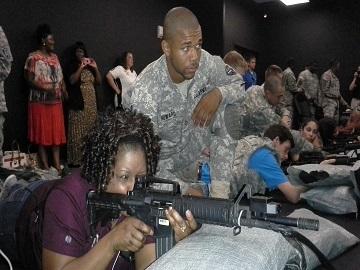
Section Branding
Header Content
Green Zone Program Helps Vets On Campus
Primary Content

As America’s military prepares to downsize, many are trading in barracks for college dorms. Some are coming home with trauma from life in war zones. And even veterans without complications like post-traumatic stress disorder can feel out of place on campus. That's why some schools are creating “Green Zones” where vets can turn for support.
It probably goes without saying that life on a college campus is really different from life on a military base. A soldier’s day usually starts before dawn and follows a strict schedule. College students, on the other hand, have a lot of free time.
Army vet and Armstrong State University student Monica Backlund says that can be kind of nice, “but at the same time that’s difficult, because you’re so used to the structure that when you don’t have it anymore, you feel a little bit lost.”
At first, Backlund also felt separate from her mostly younger classmates. She has a husband and two children and left the Army as a counterintelligence special agent -- experiences and responsibilities her fellow students generally don’t share. Backlund says those differences put her in unfamiliar territory for a senior officer: she was intimidated.
“The best thing I did for myself was be brave, and go out there and talk to those students," she says. "They’re not as scary as I thought they would be.”
Backlund says connecting with classmates can be especially important for veterans, who are used to relying on close-knit teams. She thinks feeling involved on campus makes vets more willing to reach out for help.
That’s something they often hesitate to do, says Patrick Bean, who runs the program that helps soldiers at Fort Stewart and Hunter Army Airfield transition into civilian life. He says, “the challenge always becomes having the wherewithal to say ‘I need assistance.’”
That’s where Armstrong’s Green Zone program comes in. It teaches faculty and staff how to recognize when a veteran needs help.
The cornerstone of Green Zone training is a trip to one of the nearby Army installations. Participants spend time with soldiers and get a feel for life on base. The soldiers also help faculty strap on body armor and load simulator rifles. They’re just like real M-4 rifles, except instead of bullets they fire lasers at digital enemies projected on a screen.
Armstrong Counselor Rolinda Cary says firing that training rifle helped her wrap her head around what soldiers experience. “We were using a mock setting," she says, "but in all actuality a person like me - cause when we think of our soldiers, our soldiers are just like us -- but they’re actually put in situations where they have to fire that weapon at another person."
Cary says understanding that reality helps her empathize with student veterans. “It’s crucial, I think, being able to relate to them and to just have a common ground because it makes it easier, makes them relax, and then it’s like yeah, ok, I can do this.”
Armstrong’s Green Zone program started last spring, so there aren’t many statistics yet to say how well it’s working. But programs like it have raised retention and graduation rates elsewhere. That’s according to the Aurora Foundation, which funds Green Zones on several campuses nationwide.
Armstrong modeled its Green Zone initiative on some of those schools. And officials with the University System of Georgia say they’re encouraging administrators to share ideas about how to make campuses more veteran-friendly.
Phil Gore coordinates Armstrong’s Green Zone. He says those efforts are only getting more important.
“With the drawdown, where are they going?" he says, "They’re going to our workforce, they’re coming into our schools, and we have to be proactive and we have to make sure we’re prepared.”
Officials say that’s especially true here in Georgia, where many vets choose to settle down after leaving the military.
Tags: armstrong, Armstrong State University, Army, green zone, veterans, student veterans
Bottom Content

